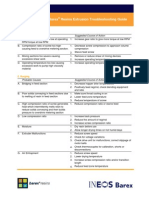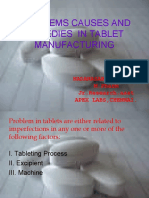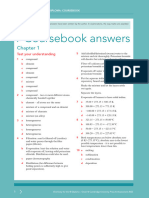0 ratings0% found this document useful (0 votes)
35 viewsTroubleshooting Guides
Troubleshooting Guides
Uploaded by
helmee kamarudinThe document provides troubleshooting guidance for common powder coating problems including chipping, cratering, off color, orange peel, poor adhesion, corrosion resistance, impact resistance, flexibility, pencil hardness, abrasion resistance, poor penetration, and dry spray. It lists the most common causes for each problem and recommends potential remedies to address the underlying causes such as increasing oven temperature or time, adjusting coating thickness, checking for contamination, and cleaning equipment.
Copyright:
Attribution Non-Commercial (BY-NC)
Available Formats
Download as DOCX, PDF, TXT or read online from Scribd
Troubleshooting Guides
Troubleshooting Guides
Uploaded by
helmee kamarudin0 ratings0% found this document useful (0 votes)
35 views3 pagesThe document provides troubleshooting guidance for common powder coating problems including chipping, cratering, off color, orange peel, poor adhesion, corrosion resistance, impact resistance, flexibility, pencil hardness, abrasion resistance, poor penetration, and dry spray. It lists the most common causes for each problem and recommends potential remedies to address the underlying causes such as increasing oven temperature or time, adjusting coating thickness, checking for contamination, and cleaning equipment.
Copyright
© Attribution Non-Commercial (BY-NC)
Available Formats
DOCX, PDF, TXT or read online from Scribd
Share this document
Did you find this document useful?
Is this content inappropriate?
The document provides troubleshooting guidance for common powder coating problems including chipping, cratering, off color, orange peel, poor adhesion, corrosion resistance, impact resistance, flexibility, pencil hardness, abrasion resistance, poor penetration, and dry spray. It lists the most common causes for each problem and recommends potential remedies to address the underlying causes such as increasing oven temperature or time, adjusting coating thickness, checking for contamination, and cleaning equipment.
Copyright:
Attribution Non-Commercial (BY-NC)
Available Formats
Download as DOCX, PDF, TXT or read online from Scribd
Download as docx, pdf, or txt
0 ratings0% found this document useful (0 votes)
35 views3 pagesTroubleshooting Guides
Troubleshooting Guides
Uploaded by
helmee kamarudinThe document provides troubleshooting guidance for common powder coating problems including chipping, cratering, off color, orange peel, poor adhesion, corrosion resistance, impact resistance, flexibility, pencil hardness, abrasion resistance, poor penetration, and dry spray. It lists the most common causes for each problem and recommends potential remedies to address the underlying causes such as increasing oven temperature or time, adjusting coating thickness, checking for contamination, and cleaning equipment.
Copyright:
Attribution Non-Commercial (BY-NC)
Available Formats
Download as DOCX, PDF, TXT or read online from Scribd
Download as docx, pdf, or txt
You are on page 1of 3
Powder Coating Problem – Troubleshooting Guidance
Problem Cause Remedy
Chipping 1. Powder not fully cured 1. Increase oven temperature, time,
or both.
2. Coating thickness too high 1. Reduce thickness by lowering
voltage or reducing spray time.
Cratering 1. Contamination with other 1. Clean the system and start with
powder virgin powder.
2. Inadequate pretreatment of 2. Check the pretreatment.
substrate
3. Contaminations with 3. Check for presence of
incompatible materials from the incompatible materials.
spray area
4. Oil or moisture in air lines 4. Check air lines; install filters if
necessary.
Off Color 1. Improper oven exhaust 1. Check exhaust vent fans.
2. Bake time too long or too short 2. Adjust the conveyor speed, oven
temperature, or both.
3. Oven temperature too high or 3. Adjust oven temperature.
too low
Orange peel 1. Warm-up of the coated 1. Check curing cycle and curing
material too slow or too fast oven; if necessary, contact your
powder supplier.
2. Heat damage to powder 2. Replace the powder.
3. Film thickness too low 3. Increase the thickness by raising
voltage or increasing spray time.
Poor 1. Inadequate cleaning or 1. Check pretreatment equipment
adhesion pretreatment and chemicals.
2. Undercured powder 2. Increase oven temperature, or
increase dwell time in oven.
3. Film thickness too high 3. Reduce thickness by lowering
voltage or reducing spray time.
Poor 1. Inadequate cleaning or 1. Check pretreatment equipment
Corrosion pretreatment and chemicals.
Resistance
2. Undercured powder 2. Increase oven temperature, or
increase dwell time in oven.
Poor impact 1. Undercured powder 1. Increase oven temperature, or
resistance or increase dwell time in oven.
poor
flexibility
2. Poor cleaning or pretreatment 2. Check pretreatment equipment
and chemicals.
3. Film thickness too high 3. Reduce film thickness by
adjusting application equipment.
4. Change in substrate thickness 4. Check substrate with supplier.
or type
Poor pencil 1. Undercured powder 1. Increase dwell time in oven.
hardness or
poor abrasion
resistance
Poor 1. Poor delivery 1. Adjust powder delivery.
penetration
(Powder
won't coat
Faraday cage
areas, such
as holes,
grooves,
channels,
inside
corners, and
recesses)
2. Poor ground 2. Check ground.
3. Improper spray pattern 3. Select proper deflector, or use
suitable barrel and cover (consult
your equipment supplier).
4. Voltage too high or too low 4. Adjust voltage settings so that
powder builds on part edges and
leading surfaces don't repel powder
from corner.
5. Poor gun placement 5. Adjust gun position so that the
powder cloud has a direct path to
the recess area.
6. Powder too fine or too coarse 6. Consult your powder supplier.
Troubleshooting Guides - Metallic Powder Coatings
Problem Cause Remedy Results
Dry-spray 1. Inadequate parts 1. Clean all contact 1. Reduces dry-spray
grounding points - zero resistance
is ideal.
2. Improper KV 2. Increase/decrease the 2. Reduces dry-spray
high voltage within the
range of 30-100 KV.
3. Excessive powder 3. Reduce Atomizing / 3. Facilitates better
velocity at the part Dosing / Dilution air charging of powder and
pressure - a softer provides more uniform
pattern is better. deposition
4. Excessive powder 4. Reduce the powder 4. Facilitates better
delivery volume delivery air pressure - do charging of powder
not spray more powder
than can be charged.
Off-Color 1. Improper KV 1. INCREASE the high 1. Will DARKEN most
voltage within the ranges metallics
of 30-100 KV.
2. Improper KV 2. DECREASE the high 2. Will LIGHTEN most
voltage within the ranges metallics
of 30-100 KV.
3. Excessive powder 3. Reduce the powder 3. Color will be more
delivery volume delivery air pressure - do uniform and will usually
not spray more powder become lighter
than can be charged.
4. Distance between gun 4. INCREASE distance. 4. Will LIGHTEN most
and part metallics
5. Distance between gun 5. DECREASE distance. 5. Will DARKEN most
and part metallics
Splitting 1. Particles collecting on 1. Utilize the electrode 1. Eliminates particle
the electrode "Rinsing-Air" or "Air- spitting
Wash" feature if
available.
2. Particles collecting on 2. Periodically clean the 2. Eliminates build-up
the deflector deflector surface with air. and spitting
3. Surging powder 3. Increase Atomizing / 3. Better powder
delivery Dosing / Dilution air deposition and more
pressure. uniform color
4. Improper KV 4. Adjust the high 4. More uniform charging
voltage within the range of powder
of 30-10KV.
You might also like
- (N. Wakao, S. Kaguei) Heat and Mass Transfer in Pa PDFDocument380 pages(N. Wakao, S. Kaguei) Heat and Mass Transfer in Pa PDFWalter MustafaNo ratings yet
- Improvised Munitions Handbook – Learn How to Make Explosive Devices & Weapons from Scratch (Warfare Skills Series): Illustrated & With Clear InstructionsFrom EverandImprovised Munitions Handbook – Learn How to Make Explosive Devices & Weapons from Scratch (Warfare Skills Series): Illustrated & With Clear InstructionsRating: 3.5 out of 5 stars3.5/5 (7)
- Force Analysis Problems (Kinematics)Document8 pagesForce Analysis Problems (Kinematics)AkibNo ratings yet
- Plastic Thermoforming - Troubleshooting PDFDocument10 pagesPlastic Thermoforming - Troubleshooting PDFshibly anastasNo ratings yet
- Solving Common Coating ProblemsDocument1 pageSolving Common Coating ProblemsNguyên Nguyễn100% (1)
- Green Sand CastingDocument14 pagesGreen Sand Castingkarthick rajaNo ratings yet
- The Application of PUR Hotmelt Adhesive As Sealant For Washing MachineDocument4 pagesThe Application of PUR Hotmelt Adhesive As Sealant For Washing MachinePankaj Choure100% (1)
- Salt Spray (Fog) Test Chamber: Installation and Use ManualDocument5 pagesSalt Spray (Fog) Test Chamber: Installation and Use ManualNguyễn Tiến Dũng33% (3)
- Astm e 28Document6 pagesAstm e 28محمد العيسوىNo ratings yet
- Astm E2860Document18 pagesAstm E2860Ricardo Martins SilvaNo ratings yet
- BASF Injection Molding Defects PDFDocument38 pagesBASF Injection Molding Defects PDFSenthil Kumar100% (1)
- Work Instruction For Defect SolvingDocument4 pagesWork Instruction For Defect SolvingBagulSurabhiNo ratings yet
- Remediealsolutionincottonwetprocessingshroff 140509102039 Phpapp01Document52 pagesRemediealsolutionincottonwetprocessingshroff 140509102039 Phpapp01Chiman VaghasiaNo ratings yet
- Low Volume Low Pressure: Model No. R500Document7 pagesLow Volume Low Pressure: Model No. R500Joe TourmaNo ratings yet
- Extrusion TroubleshootingDocument7 pagesExtrusion Troubleshootingziradagreat539100% (1)
- Manual de usuario Secador de lecho fluidoDocument16 pagesManual de usuario Secador de lecho fluidoJulyan TombeNo ratings yet
- Powder Coating Troubleshoothing Revised 7 10 14Document30 pagesPowder Coating Troubleshoothing Revised 7 10 14Mina RemonNo ratings yet
- Troubleshooting Rough or Dull SurfaceDocument3 pagesTroubleshooting Rough or Dull SurfaceAntonius PrakosaNo ratings yet
- Compression BasicDocument24 pagesCompression BasicEKA NURUL FALAH 02511740000082100% (1)
- Steel Fiber Laser Cutting Common Problems and Solutions - UNIQUE CNCDocument8 pagesSteel Fiber Laser Cutting Common Problems and Solutions - UNIQUE CNCM Sathi BabuNo ratings yet
- SPRAYIT SP-33500 LVLP Gravity Feed Mini Spray Gun 6-13Document8 pagesSPRAYIT SP-33500 LVLP Gravity Feed Mini Spray Gun 6-13dysan 45No ratings yet
- Sprayit Gravity Feed Spray Gun SPRAYITDocument8 pagesSprayit Gravity Feed Spray Gun SPRAYITLuís GuerreiroNo ratings yet
- Laminating Troubleshooting Khalid GhouzaliDocument16 pagesLaminating Troubleshooting Khalid GhouzaliHoang DinhNo ratings yet
- SF Operation ManualDocument5 pagesSF Operation ManualArfil Sta Ana YongcoNo ratings yet
- Nylon 6 Resins Correcting Molding Problems A Trouble Shooting GuideDocument12 pagesNylon 6 Resins Correcting Molding Problems A Trouble Shooting Guidebala sivakasanNo ratings yet
- Troubleshooting Guide For Blow MoldingDocument3 pagesTroubleshooting Guide For Blow Moldingwoongs73100% (1)
- Atlas of Casting DefectsDocument23 pagesAtlas of Casting Defectsvannetzel.maximeNo ratings yet
- User and Trouble Shooting Guide Black Oxide CoatingsDocument6 pagesUser and Trouble Shooting Guide Black Oxide CoatingsDCG CandyNo ratings yet
- Astm F 1929-98Document3 pagesAstm F 1929-98elvisonderNo ratings yet
- Printing Non ConformancesDocument2 pagesPrinting Non ConformancesMATTHEW MUNGAINo ratings yet
- Problems Causes and Remedies in Tablet Manufacturing & CoatingDocument28 pagesProblems Causes and Remedies in Tablet Manufacturing & CoatingPhArMaCyGrAdUaTeS100% (1)
- GC-Packed Column-TroubleshootingDocument2 pagesGC-Packed Column-TroubleshootingAprie SubektiNo ratings yet
- 9files (1-35)Document36 pages9files (1-35)JAVED KHANNo ratings yet
- Problems Causes and Remedies in Tablet Manufacturing: Nadanasabapathi.P., M.Pharm JR - Research.asst Apex Labs, ChennaiDocument28 pagesProblems Causes and Remedies in Tablet Manufacturing: Nadanasabapathi.P., M.Pharm JR - Research.asst Apex Labs, Chennaiabhi8554No ratings yet
- TISI03 IX M Dev& Fix E04 07-14 CHIMIEDocument5 pagesTISI03 IX M Dev& Fix E04 07-14 CHIMIEwalid walidNo ratings yet
- Microfeed Extrusion Process Aqua 2019Document41 pagesMicrofeed Extrusion Process Aqua 2019daravellaNo ratings yet
- TWI - NDT IntroduzioneDocument77 pagesTWI - NDT Introduzionessnair85No ratings yet
- Defects PPT FinalDocument21 pagesDefects PPT FinalHimali Lalwani100% (1)
- Laboratory 2.1 Pure Culture TechniquesDocument2 pagesLaboratory 2.1 Pure Culture TechniquesJerome LisingNo ratings yet
- Glaze defects & adjustmentsDocument2 pagesGlaze defects & adjustmentsmontychaudhary200No ratings yet
- D 1849 - 95 R03 - Rde4ndkDocument2 pagesD 1849 - 95 R03 - Rde4ndkNeftali DoriaNo ratings yet
- Factors Affecting Evaporation: ObjectiveDocument3 pagesFactors Affecting Evaporation: ObjectiveL LHNo ratings yet
- Sunflag Iron & Steel Company Limited: Continuous CastingDocument30 pagesSunflag Iron & Steel Company Limited: Continuous Castingamit gajbhiye100% (2)
- Flexo Trouble Shooting Coloured PDFDocument28 pagesFlexo Trouble Shooting Coloured PDFliebofreakNo ratings yet
- Surface Defects in Powder Coating: 1.1 Craters Possible Causes SolutionDocument2 pagesSurface Defects in Powder Coating: 1.1 Craters Possible Causes SolutionEidrish ShaikhNo ratings yet
- Powder Coating Trouble Shooting TVSMDocument34 pagesPowder Coating Trouble Shooting TVSMPinnacle qualityNo ratings yet
- 4) Astm D1644 (Voc)Document2 pages4) Astm D1644 (Voc)Mahendra Singh BudhathokiNo ratings yet
- 61 BBD 79366 FC 5Document4 pages61 BBD 79366 FC 5ETTE PRAKASH REDDY నాన్న కి ప్రేమతోNo ratings yet
- Sample Chapter Campbell-SpaldingDocument22 pagesSample Chapter Campbell-SpaldingAli RazuNo ratings yet
- Causes and Cures of Common Welding TroublesDocument1 pageCauses and Cures of Common Welding TroublesaneesNo ratings yet
- Powder Caoting Defects and ActionsDocument8 pagesPowder Caoting Defects and ActionsManoharar RNo ratings yet
- Causes and Cures of Common Welding TroublesDocument1 pageCauses and Cures of Common Welding TroublesRathnakrajaNo ratings yet
- General Thermoforming and Cutting Troubleshooting GuideDocument5 pagesGeneral Thermoforming and Cutting Troubleshooting GuideHiếu Mai ĐứcNo ratings yet
- D 1849 - 95 Rde4ndktotuDocument2 pagesD 1849 - 95 Rde4ndktotuAri SupramonoNo ratings yet
- DryingDocument2 pagesDryingPawan KumarNo ratings yet
- Casting Defects and RemediesDocument7 pagesCasting Defects and Remediesvignesh waran sNo ratings yet
- Fishbone 2Document3 pagesFishbone 2Piyush ChaudhariNo ratings yet
- Practical Sheet - DHV20043 - PS 02 & 3Document15 pagesPractical Sheet - DHV20043 - PS 02 & 3HazymNo ratings yet
- Solubility of Asphalt Materials in Trichloroethylene: Standard Test Method ForDocument3 pagesSolubility of Asphalt Materials in Trichloroethylene: Standard Test Method ForMohamed NedalNo ratings yet
- Laboratory Manual of Glass-BlowingFrom EverandLaboratory Manual of Glass-BlowingRating: 5 out of 5 stars5/5 (2)
- Improvised Munitions: Illustrated ManualFrom EverandImprovised Munitions: Illustrated ManualRating: 5 out of 5 stars5/5 (1)
- Improvised Weapons & Munitions: U.S. Army Ultimate HandbookFrom EverandImprovised Weapons & Munitions: U.S. Army Ultimate HandbookNo ratings yet
- (Additional) Self - Mutual InductancesDocument10 pages(Additional) Self - Mutual InductancesBT21EE017 Gulshan RajNo ratings yet
- Microstreaming Effects On Particle Concentration in An Ultrasonic Standing WaveDocument10 pagesMicrostreaming Effects On Particle Concentration in An Ultrasonic Standing WavedevendrakphyNo ratings yet
- Kendriya Vidyalaya VSN Nagpur Xii Q PDocument2 pagesKendriya Vidyalaya VSN Nagpur Xii Q PAryan BeleNo ratings yet
- Solved Exmaples PDFDocument2 pagesSolved Exmaples PDFnigus hailu100% (1)
- Linac Closed-Loop Water Cooling System FAQsDocument7 pagesLinac Closed-Loop Water Cooling System FAQsMiguel Angel Palos M.No ratings yet
- Lab Report Structural MechanicsDocument40 pagesLab Report Structural Mechanicsmalicat alwrood0% (1)
- Current Electricity 2Document12 pagesCurrent Electricity 2aanishahossain18No ratings yet
- ASTM B 117 Trivalent & Chrome Free Finsihes Hour To Whie Corrosion ComparisonDocument1 pageASTM B 117 Trivalent & Chrome Free Finsihes Hour To Whie Corrosion Comparisonvichun sakunyongNo ratings yet
- Fear Robertson Undrainedstrengthofsands CGJ1995Document13 pagesFear Robertson Undrainedstrengthofsands CGJ1995Ten FreireNo ratings yet
- Literature Review On Carbon SteelDocument7 pagesLiterature Review On Carbon Steelc5p0cd99100% (1)
- Statistical Physics: Xford HysicsDocument21 pagesStatistical Physics: Xford HysicsasdNo ratings yet
- Radiation Physics Lecture NotesDocument33 pagesRadiation Physics Lecture NotesLahiru PereraNo ratings yet
- Ib Chemistry 1ed TR CB AnsDocument155 pagesIb Chemistry 1ed TR CB AnsPassent ElewaNo ratings yet
- 5067-0223 Gas Flow Meter Reference Manual 5973-1712Document42 pages5067-0223 Gas Flow Meter Reference Manual 5973-1712Marine JolieNo ratings yet
- Lecture Notes: Condensed Matter Theory I (TKM1) : J. SchmalianDocument70 pagesLecture Notes: Condensed Matter Theory I (TKM1) : J. SchmalianPragyanPhukanNo ratings yet
- Assignment On Temperature Sensors.: February 2018Document8 pagesAssignment On Temperature Sensors.: February 2018Manoj Kumar RajNo ratings yet
- Student Exploration: Golf RangeDocument6 pagesStudent Exploration: Golf RangeNicholas chinNo ratings yet
- F at Each Wheel. Assume A Constant Deceleration For The 1500-kg CarDocument12 pagesF at Each Wheel. Assume A Constant Deceleration For The 1500-kg CarAndre BocoNo ratings yet
- Description Unit Unit - I: Turbine Heat Rate CalculationDocument7 pagesDescription Unit Unit - I: Turbine Heat Rate CalculationRameez FaroukNo ratings yet
- Bars Classification Anode Load Week 36: El SalvadorDocument24 pagesBars Classification Anode Load Week 36: El Salvador00015800No ratings yet
- Api 674Document2 pagesApi 674Francesca CoattiNo ratings yet
- Operating Instruction Manual Of: Junker's Gas CalorimeterDocument5 pagesOperating Instruction Manual Of: Junker's Gas CalorimeterService MMINo ratings yet
- Failure AnalysisDocument16 pagesFailure AnalysisPrimitivo GonzálezNo ratings yet
- En bf880 PDFDocument1 pageEn bf880 PDFshaonaaNo ratings yet
- P0004RevA - Guide To Container DefectsDocument1 pageP0004RevA - Guide To Container Defectsporix86No ratings yet
- Jurnal Zeolit PDFDocument10 pagesJurnal Zeolit PDFAnnizah Rahmatya GerhanaNo ratings yet
- TrussesDocument21 pagesTrussesShepherd NhangaNo ratings yet

























































































